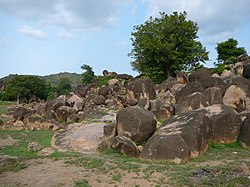This article needs to be updated.(January 2020) |
Upper East Region, Dagbon | |
|---|---|
 Rock formation in the Tongo Hills near Gorogo | |
 Location of Upper East Region in Ghana | |
| Country | Ghana |
| Capital | Bolgatanga |
| Districts | 10 |
| Government | |
| • Regional Minister | Akamugri Donatus Atanga [1] |
| Area | |
• Total | 8,842 km2 (3,414 sq mi) |
| • Rank | Ranked 9th |
| Population (2021 Census) [3] | |
• Total | 1,301,226 |
| • Rank | Ranked 9th |
| • Density | 147.2/km2 (381.2/sq mi) |
| GDP (PPP) | |
| • Year | 2013 |
| • Per capita | $5,150 |
| GDP (Nominal) | |
| • Year | 2013 |
| • Per capita | $2,500 |
| Time zone | GMT |
| Area code | 039 |
| ISO 3166 code | GH-UE |
| HDI (2017) | 0.520 [4] low · 8th |
The Upper East Region is located in the northern part of Ghana, [5] and it is the third smallest of the 16 administrative regions in Ghana. Despite its relatively small size, the region holds an outsized significance in the nation's cultural heritage and historical narrative. It occupies a total land surface of 8,842 square kilometers, hence constituting a modest 2.7% of Ghana's total land area. The regional capital is Bolgatanga, which is sometimes referred to as Bolga. [6] [7] It is a major center for the production and sale of beautifully woven baskets, leather goods, and straw handicrafts. Bolga serves as the administrative and commercial heartbeat of the region. Other major towns in the region include Navrongo, Paga, Sandema, Bawku, Zebilla, Tempane, Pusiga, Garu, Pwalugu, and Widana. [8]

